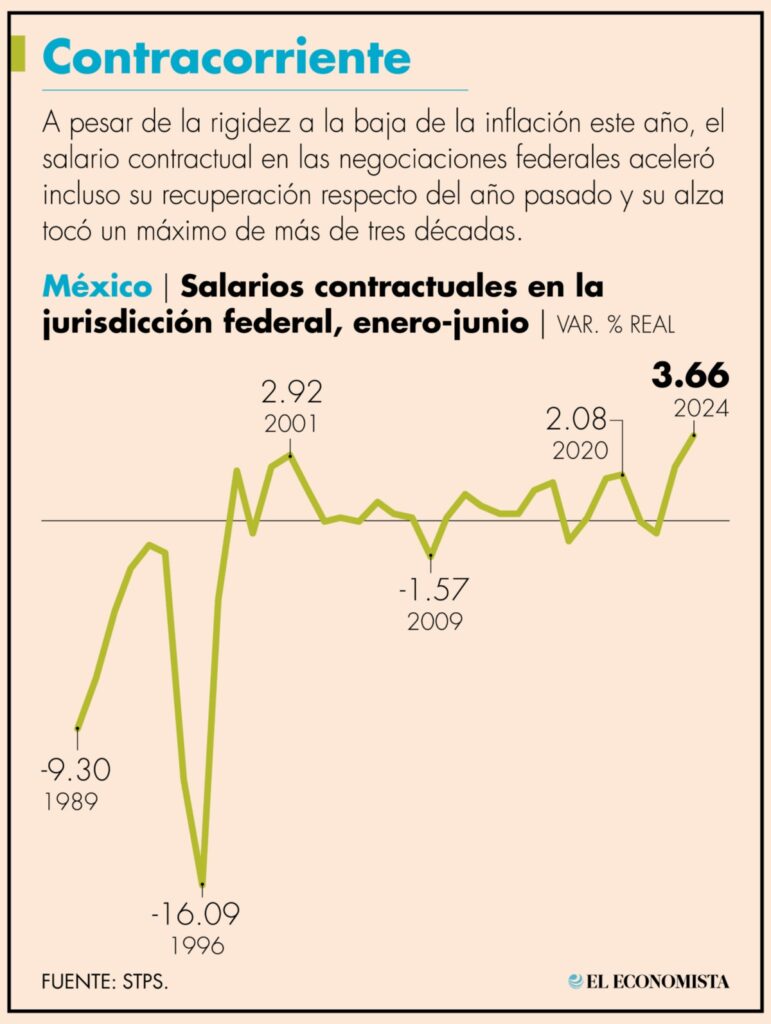
In June, the reviews of contractual salaries reached an accumulated real growth of 3.66% so far in 2024 and, thus, they recorded their highest figure in history for a first half of the year, according to information from the Department of Labor and Social Welfare (STPS).
With the January-June results, remunerations of unionized personnel within the federal jurisdiction had 18 consecutive months with positive balances in real terms, while losses were observed in 2022 during more than half of the year.
“Inflation has become only one of the parameters, but is no longer the guiding principle or the main element in collective bargaining, and this is posing an important challenge for companies”, says Blanya Correal, director of the Labor Engineering Division at D&M and partner at TAMIM HR Consulting.
From the perspective of the specialist, the historical growth of contractual salaries is linked to aspects such as pressure from the increases to the minimum wage in some collective bargaining agreement tabulators, the demands made by the union base on their union leaders for better negotiations and the retention of specialized profiles in face of the arrival of new companies as a result of the nearshoring phenomenon.
Up to now, the highest real increases registered by the STPS for a January-June term were those of 2000 (2.40%) and 2001 (2.92%). The first semester of last year started getting closer to these levels, with 2.30 percent.
In June of this year, the nominal increase of remunerations for unionized personnel was 9.7%, the highest so far this year. This translated into a real increase of 4.5%, the same level seen last March, the months with the best balance in the first half of 2024.
The Department of Labor itself has attributed the good performance of contractual salaries “to the union strength brought about by the labor reform, as 30,000 collective bargaining agreements have been legitimized, involving the call to 5 million workers to decide their endorsement through their personal, free, direct, and secret vote, that is, negotiations with the true support of the workers that benefit from them were successfully completed.”
The agency points out that contractual increases have been achieved by unions grouped in all union federations and in spite of an “adverse international panorama, with the Covid 19 pandemic and the increase in inflation, product of the war conflict between Russia and Ukraine.”
“The yearly increases (to the minimum wage) starting on 2017 are not the same ones that have been applied in the public sector, and even less so in the private sector, when we speak of contractual salaries. In some years, increases have even been below inflation, which means that the deterioration of contractual salaries has progressed”, explains Luis Bueno, president of the Center for Labor Research and Union Consulting (Cilas).
According to the specialist, contractual salaries had a loss of purchasing power similar to that of the minimum wage. In this sense, Luis Bueno points out that the performance of increases in remunerations “does not yet show a trend toward the recovery of contractual salaries, there is nothing to indicate that. On the contrary, in everyday life we see inflation rates that do not correspond to the official numbers.”
Mexico has good wage growth in the OECD
In a general overview of salaries, Mexico is among the main economies with the greatest growth in remuneration among the countries that comprise the Organization for Economic Cooperation and Development (OECD).
“In comparison with the majority of OECD countries, Mexico has shown a remarkable recovery in salaries”, the organization points out in its Employment Outlook 2024 report.
Within a period of five years, the report points out, salaries in Mexico increased by 5.4% in real terms; this performance was better than that of the main trade partners, with decreases of 2.4% in Canada and 0.8% in the United States.
Increases to the minimum wage explain a part of this trend. In fact, the OECD positions Mexico as the economy with the best real increase in basic remuneration. Between 2019 and 2023, the salary reference in the country had a real growth of 86.6%; this was 6.7 times higher than the average of the member nations.


